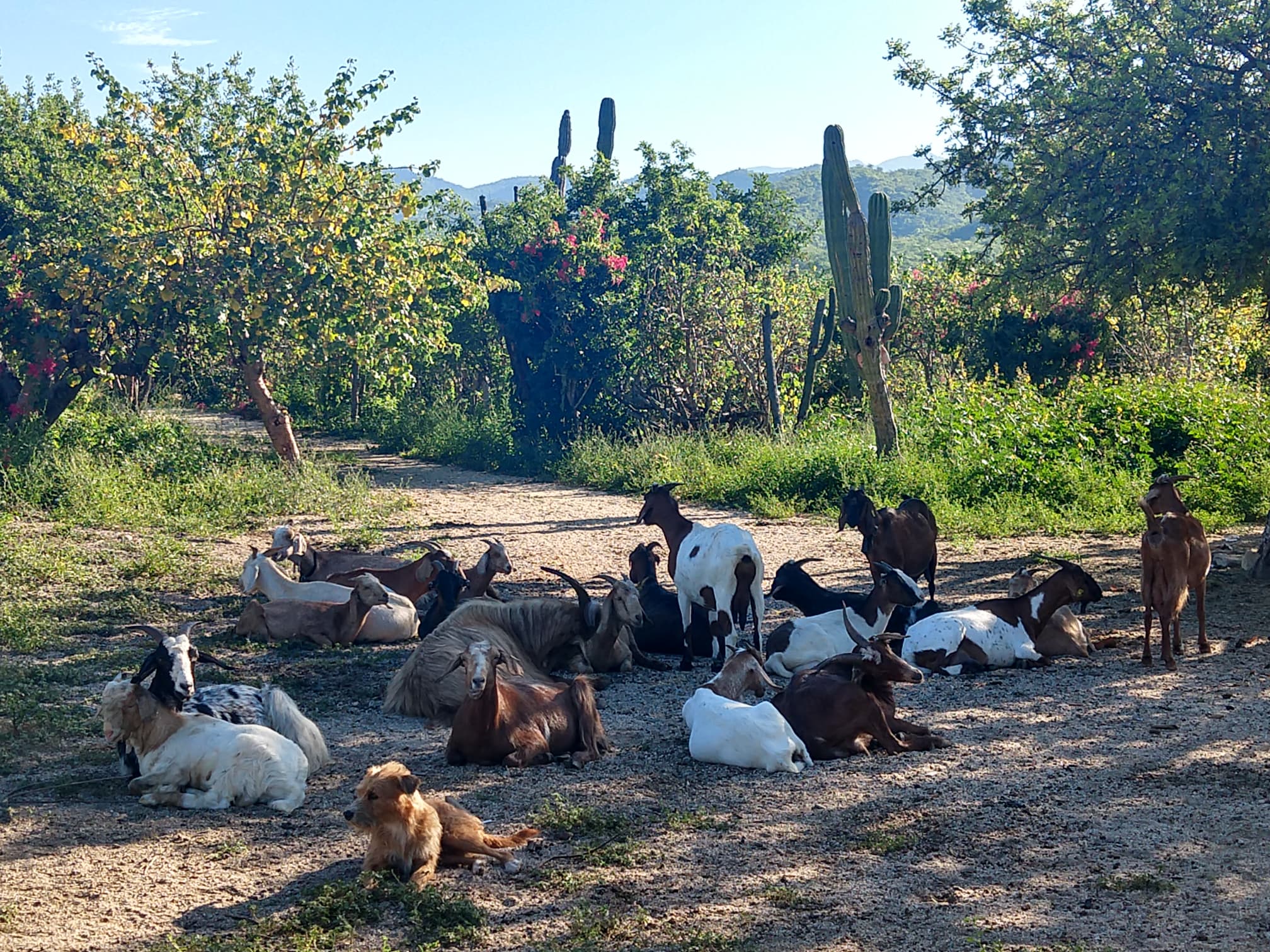Biochemical and mineral composition of plant species consumed by goats under rangeland system in three seasons of the year
Composición bioquímica y mineral de especies vegetales consumidas por cabras en pastoreo en tres temporadas del año

This work is licensed under a Creative Commons Attribution-NonCommercial-ShareAlike 4.0 International License.
Show authors biography
Objetive. Determine and compare the biochemical and mineral composition of plant species consumed by grazing goats in three seasons of the year (drought, rain, and transition). Materials and methods. Sampling of the plant species that consume goats in each season of the year were made, during the time the goats feed on the rangeland, following them by the feeding paths and registering the species, the organs consumed, and the proportion of consumption This data were used to calculate a preference index, registering the frequency of consumption The three most consumed species by goats per season were selected. Results. The most consumed species in the drought season were Cyrtocarpa edulis, Pithecollobium confine, and Cercidium floridum. During the rainy season, the most consumed species were Forchhammeria watsonii, Tecoma stans, and Cercidium floridum. The most consumed species during rainy season were, Cyrtocarpa edulis, Indigofera suffruticosa, and Mimosa distachya. The protein content and ethereal extract were superior (p≤0.05) in the drought season. The content of Ca, Mg, Mn, K, P, and total-N were superior (p≤0.05) in the rainy season. Conclusions. The plant species associated with the rangeland in the study area, showed variation per season of the year in mineral and biochemical content, although are a source of minerals and nutrients for goats.
Article visits 216 | PDF visits
Downloads
- Domínguez R, Guillen A, León J, Murillo B. Estimación y disponibilidad forrajera de arbustos en Baja California Sur, México. Interciencia. 2003; 28(4):229-233. http://ve.scielo.org/scielo.php?script=sci_arttext&pid=S0378-18442003000400009&lng=es&nrm=iso
- Mellado M. Dietary selection by goats and the implications for range management in the Chihuahuan Desert: a review. Rangel J. 2016; 38(4):331–341. https://doi.org/10.1071/RJ16002
- Medina N, Espinoza JL, Ávila NY, Murillo B. Composición química de forrajes del agostadero y su relación con la composición química de leche de cabras criollas. Interciencia. 2013; 38(2):132-138. https://www.interciencia.net/wp-content/uploads/2017/12/132-c-MURILLO-7.pdf
- Martinez M, Perez H, Perez A, Carrion P, Gomez C. Nutrient limits in diets for growing dairy goats. Arch Med Vet. 2012; 44(1):13-20. http://dx.doi.org/10.4067/S0301-732X2012000100003
- Junco E, González H, Armenta JL, Cantú I, Estrada A, Cotera M, Gómez M. Composición botánica del matorral sarcocaule en Baja California Sur durante las estaciones húmeda y seca. Rev Mex Cienc Forestales. 2020; 11(61):1-24. https://cienciasforestales.inifap.gob.mx/index.php/forestales/article/view/730
- León JL, Domínguez R, Medel A. Florística de la selva baja caducifolia de la península de Baja California, México. Bot Sci. 2012; 90(2):143-162. https://doi.org/10.17129/botsci.480
- Ngwa AT, Pone DK, Mafeni JM. Feed selection and dietary preferences of forage by small ruminants grazing natural pastures in the Sahelian zone of Cameroon. Anim. Feed Sci. Technol. 2000; 88(3):253-266. https://doi.org/10.1016/S0377-8401(00)00215-7
- Velásquez-Vélez R, Pezo D, Skarpe C, Ibrahim M, Mora J, Benjamín T. Selectividad animal de forrajes herbáceos y leñosos en pasturas seminaturales en Muy Muy, Nicaragua. Agrofor. Am. 2009; 47(1):51-60. https://repositorio.catie.ac.cr/bitstream/handle/11554/7618/RAFA_47_Completa.pdf?sequence=1&isAllowed=y
- Little TM, Hills FJ. Métodos estadísticos para la investigación en la agricultura. México: Ed. Trillas; 1989.
- Steel GDR, Torrie JH. Bioestadística. Principios y procedimientos. México: Ed. McGraw Hill; 1995.
- Mashwani R, Khan M, Ahmad M, Zafar M, Iqbal N, Arshad M, Samiullah. Macro-mineral quantification of the forage grass species in the Gandgar Hills, Western Himalaya, Pakistan. Pak J Bot. 2012; 44(1):117-121. http://www.pakbs.org/pjbot/PDFs/44(SI1)/17.pdf
- Medina N, Espinoza J, Avila N, Murillo B. Evaluation of minerals of shrub plant forages consumed by goats in the arid southern rangeland of the Peninsula of Baja California, Mexico. Anim Nutr Feed Technol. 2014; 14(3):511-522. https://doi.org/10.5958/0974-181X.2014.01354.7
- Allegretti L, Sartor C, Paez Lamaa S, Egea V, Fucili M, Passera C. Effect of the physiological state of criollo goats on the botanical composition of their diet in NE Mendoza, Argentina. Small Rumin. Res. 2012; 103(2-3):152–157. https://doi.org/10.1016/j.smallrumres.2011.09.018
- Mukaram S, Hussain F. Evaluation of Micro-Minerals and Nutritional Status of Some Forage Grasses in Mastuj Valley, Hindukush Range, Pakistan. Pak J Nutr. 2014; 13(11):622-625. https://doi.org/10.3923/pjn.2014.622.625
- Dutta Tk, Das A, Tripathi P, Dular R. Effect of concentrate supplementation on growth, nutrient availability, carcass traits and meat quality in barbari kids reared under semi-intensive and intensive systems. Anim Nutr Feed Technol. 2020; 20(2):267-278. https://doi.org/10.5958/0974-181X.2020.00024.4
- Dayenoff P, Macario J, Kotani I, Roberi J, Gorrachategui MS, Nicolas A, Bolaño M. Forage quality of goat intake, in the South Central Plateau of Mendoza (Argentina). Ciencia Veterinaria. 2023; 25(2):124-136. https://doi.org/10.19137/cienvet202325202
- Hozza WA, Kifaro GC, Safari JG, Mushi DE. Effect of concentrate supplementation levels on growth and slaughter characteristics of SEA and SEA × Norwegian goats under on-farm conditions. Trop Anim Health Prod. 2013; 45(8):1789-94. https://doi.org/10.1007/s11250-013-0436-x
- Dutta TK, Mamta, Chatterjee A, Bhakat C, Mandal DK, Rai S, et al. Effect of different levels of concentrate supplementation on feed intake, growth performance, carcass traits and composition in finisher Barbari kids reared under intensive system. Indian J Anim Sci. 2023; 93(1):82–89. https://doi.org/10.56093/ijans.v93i1.127288
























